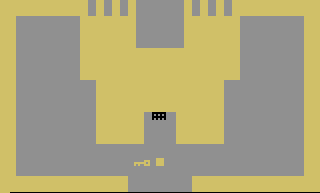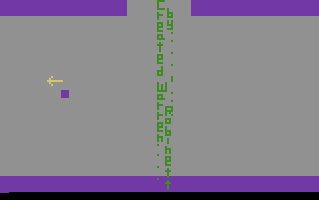 ... ...
Several years ago, I wrote an article in which I called Adventure for the Atari 2600 one of the most overrated games I'd ever played. While that's not a sentiment I'm willing to rescind anytime soon, it should be noted that there is (sometimes) a difference between saying a game is overrated and saying it's bad or that you don't like it.
I don't know how old I was or what year exactly it was when I first heard about Adventure, but I know I was at most a child in elementary school sometime in the early 80's, and the idea of the game sounded absolutely fascinating to me. Worlds with castles, dragons, swords, and magic sparked my imagination in my youth and the ability to explore and navigate such a world was a dream-come-true.
When the inevitable day came that I was able to play Adventure (at a cousin's house, during a holiday visit), I completed all three of the difficulty settings in far less than an afternoon and was left feeling somewhat underwhelmed to say the least. This was so often the case with Atari 2600 experiences, due to its (very) limited technology, that in some ways I find it hard to fault the game too much for it. Later, more advanced 2600 adventure games like Raiders of the Lost Ark and E.T. The Extra-Terrestrial would prove to be too complicated for many gamers to figure out and solve on their own. So, maybe for games in which the controller only has one button, simpler is better.
 
In Adventure you guide a square-shaped hero through an abstract world that, with some imagination, might resemble a fantasy landscape. There are three castles and a key that unlocks each, several other helpful items lying around, and a basic premise: Retrieve the stolen Magic Chalice from the Black Castle and return it to the Golden Castle to win. Hindering your progress are three dragons that attempt to swallow you whole (thus giving you the only possible "game over" aside from some glitches that could leave you unable to progress any further), a bat with erratic flight patterns that steals your items, and several mazes, some of which are shrouded in darkness making it (somewhat) difficult to find your way through.
Like many 2600 games, Adventure's challenge depends on the setting you choose before you begin. The first (of three) settings is missing some of the dragons, mazes, and the White Castle, thus making it the easiest to complete. The second setting adds in the missing elements, but always generates the items in the exact same locations making the solution the same every time. There is only one true puzzle on this mode, and it shouldn't take any gamer long to figure it out. The third setting contains all the same elements as the second, but it generates the items randomly around the game world (except the Chalice, which remains in the Black Castle). While it does not change the gameplay drastically, it is the only way in which Adventure has any replay value at all. (Unfortunately, sometimes a key is generated inside the castle that requires it, thus leaving you unable to complete the game.)
The problem with Adventure is that at face value, there just isn't enough to it. While you can goof around to find some glitches and even a hidden programmer's room (the first known videogame Easter Egg of its kind), these are merely artificial ways of prolonging interest in it. The blocky graphics are not likely to inspire the illusion of a sprawling kingdom in even the most Muppet Baby-minded of individuals. Although the castles have become rather iconic videogame imagery, some of the empty areas could have used a tree or two to provide more of that medieval outdoors feel. It's been often-reported that the dragons look more like ducks, which is funny in retrospect, but disappointing to a child who was expecting a fantasy world with actual dragons.
 
Despite its primitive nature and simplicity, Adventure is a game that is difficult to dislike, as there is nothing offensively bad about it or wrong with it. It's hard to say if it was any influence on modern adventure games (Shigeru Miyamoto claims that The Legend of Zelda was inspired by his childhood adventures exploring natural areas around his home, not by any previous game), so even reommending it as a "see where it all began" experience would be tenuous at best. However, since anyone who hasn't yet played an Atari 2600 game is most likely to do so these days by downloading a ROM, which is free and takes only a few minutes of your time, it probably won't hurt to give it a try, either. At least I've exposed the reality of the situation to you beforehand.
OVERALL
SCORE: 2/5
BACK TO ATARI 2600 REVIEWS BACK TO MAIN
PAGE |

